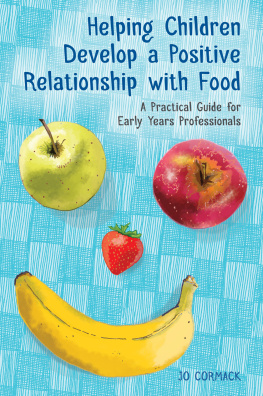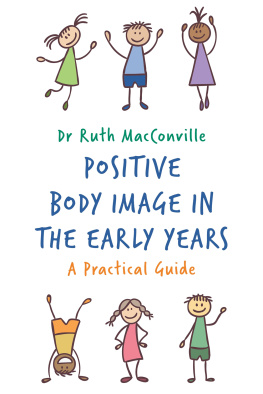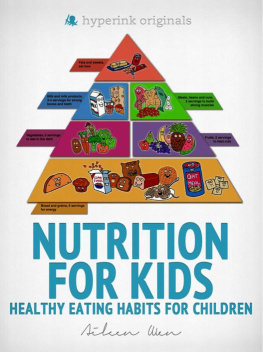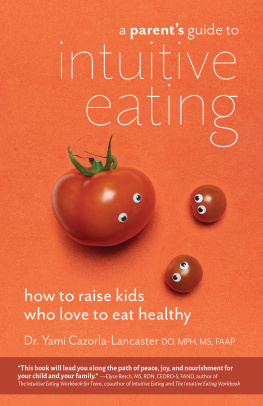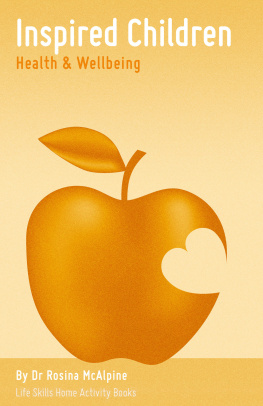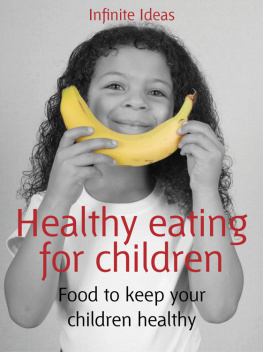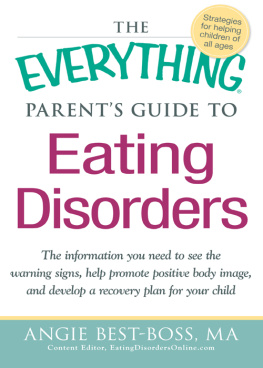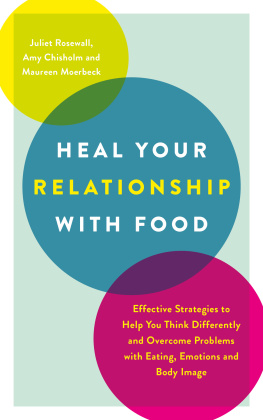
Helping Children
Develop a Positive
Relationship with Food
A Practical Guide for
Early Years Professionals
JO CORMACK

Jessica Kingsley Publishers
London and Philadelphia
Contents
INTRODUCTION
We eat several times a day, each and every day. Food is a huge part of our routine in fact, our very lives depend on it! For most children, eating can be a pleasurable experience, or at least something they do without thinking too much about it. For others, food can be an extremely challenging and complex area.
BACKGROUND
I wrote this book with three key goals in mind: first, to offer an accessible overview of some important theoretical concepts relating to how children eat; second, to offer some guidance (relevant to all children) on best practice in relation to food in an early years context; and third, to serve as a guide for early years practitioners who wish to feel confident about how to support children who may have a problematic relationship with food, with a particular focus on picky eating.
Although the government has recognised that there is a problem in terms of what foods children are eating, historically the key focus has been on increasing fruit and vegetable consumption.
I am a therapist, feeding consultant and doctoral researcher (exploring picky eating) and my interest in childrens eating is concerned with the psychological, behavioural and emotional aspects of food and feeding. I am not a dietitian and this book is not really about what to feed children, so much as how . Of course, nutrition is a big part of the picture, but there are other books and guidance documents available which provide information about nutrition in an early years context.
This book is for you if you want to know more about the psychology of childrens eating and about how to help them enjoy a varied and healthy diet. It is also for you if you want to know more about how to help children in your care who may struggle with challenges like being overweight or picky eating. There is an emphasis on working with parents and carers and on meeting your obligations as set out in the Early Years Foundation Stage (EYFS) Framework.
A FRESH LOOK AT HOW WE FEED CHILDREN
Many of the concepts in this book challenge cultural norms in relation to feeding children. I invite you to step back, take a look at the research and re-appraise some assumptions that you may hold. While academic research into how we feed children is a burgeoning area in the UK, this has not translated into practice, either in terms of parenting or in an educational context. In this book, I draw particularly on the work of American feeding specialists and academics and share some ideas which are better known across the pond.
This book is all about shifting the goal posts: moving from the short term aim of get food down child, to the longer term aim of foster a positive relationship with food. There are so many reasons why we feel that getting children to eat should be our main priority. I attempt to unpick these and offer an evidence-based alternative.
HOW TO USE THIS BOOK
There is more than one way to use this book. You can read it from cover to cover and gain an in-depth understanding of how to help children develop a positive relationship with food. You can also use it as a reference, going straight to a chapter or section which is relevant for you at a particular time. This is especially true of Section 10, in which I look in detail at specific issues like autism spectrum disorder (ASD) and sensory processing in relation to eating. However, a word of caution: if you approach the book in this way, first read Sections 1 and 2 where I introduce some very important concepts which are necessary to an understanding of the rest of the book.
WHO IS THIS BOOK FOR?
Whether you are a nursery assistant, childminder, teacher or nursery manager, I hope there will be something in this book which will be of value to you. Some aspects of it are quite theoretical, because I think it is important to understand the rationale and evidence base underpinning the practical suggestions I make. Where it is included, I have tried to express theory in an accessible and meaningful way. Conversely, other aspects of this book are very much grounded in day-to-day practice. If you are an early years practitioner and any part of your work involves feeding children, I have written this book for you.
THINGS TO BE AWARE OF WHEN READING THIS BOOK
Where I use the term parent or parents this is shorthand for parents and carers. I understand that many people who may not be a childs parent take on the parental role.
In order to protect anonymity, the case studies (except the one in Section 11) are fictitious but draw on elements of real situations and experiences.
While much of the theory is relevant to all children, feeding babies and toddlers under two is not covered in this book. This is a specialist area requiring a separate focus.
A NOTE ABOUT THE CHILDRENS FOOD TRUST
The Childrens Food Trust has been responsible for some extremely important work in relation to childrens health and wellbeing in the UK. At the time of writing, they have very sadly announced their closure. I refer to and recommend several of their resources in certain sections of this book. You can still read and download these on their website despite their closure, as they will continue to be available.
SECTION 1
ALL ABOUT A GOOD
RELATIONSHIP WITH FOOD
In the first section of this book, we will think about what constitutes a good relationship with food and why it is important. I will introduce you to some key concepts which are essential to an understanding of how to promote and support a positive relationship with food. The most important of these is self-regulation an idea that we will be coming back to again and again as we think about how children eat and how to feed them. I will invite you to reflect on what our role is in relation to feeding children and will introduce you to American feeding expert, Ellyn Satters division of responsibility model, which proposes an answer to this question. Finally, we will explore the importance of exposure and variety in helping children develop a positive relationship with food.
Chapter 1
WHAT IS A POSITIVE
RELATIONSHIP WITH FOOD
AND WHY DOES IT MATTER?
WHAT EXACTLY IS A POSITIVE RELATIONSHIP WITH FOOD?
This is one of those apparently simple questions that is really quite difficult to answer. Like many things, we know it when we see it. If we spot a child eating lots of different, nourishing foods with enjoyment and gusto, we might want to say that they have a positive relationship with food. But can we define it? Can we get closer to describing what a positive relationship with food is all about, in order to help children move closer to attaining this lofty ideal?
NUTRITION
Nutrition is a key aspect of a positive relationship with food. Children need to be adequately nourished in order to fully engage with the curriculum and access all of the opportunities available to them in whatever setting they attend.
Most early years practitioners will be familiar with Maslows hierarchy of needs. Maslow argued that, before higher level needs can be met (like the need for belonging or for self-esteem) more basic needs (like the need to be safe) have to be addressed. He expressed this theory visually, as a pyramid. At the very base of Maslows pyramid are our physiological needs. These are the things our bodies require in order to work properly.
Just as a child who has not had enough sleep, or a child who is unwell, cannot function at full capacity, a child who has a very poor diet is at a disadvantage. Of course, there are many reasons why children might not to be able to access a healthy diet (including socio-economic factors) but sometimes it might be their negative relationship with food that is preventing them from reaching their full potential.
Next page
